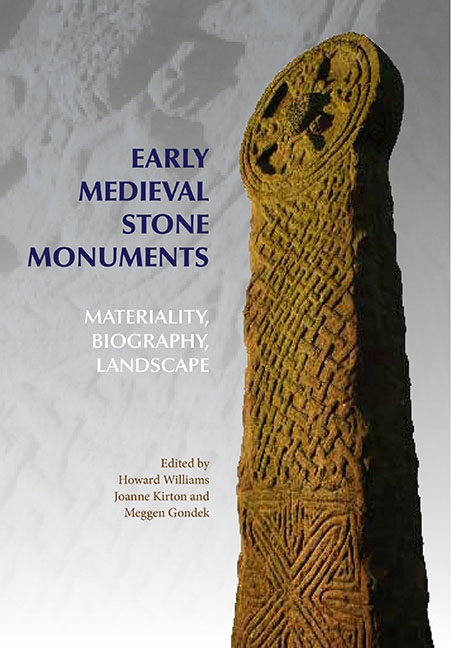Book contents
- Frontmatter
- Dedication
- Contents
- List of Illustrations
- List of Tables
- Acknowledgements
- 1 Introduction: Stones in Substance, Space and Time
- 2 Locating the Cleulow Cross: Materiality, Place and Landscape
- 3 Walking Down Memory Lane: Rune-Stones as Mnemonic Agents in the Landscapes of Late Viking-Age Scandinavia
- 4 Building Blocks: Structural Contexts and Carved Stones in Early Medieval Northern Britain
- 5 Memory, Belief and Identity: Remembering the Dead on Iniscealtra, Co. Clare
- 6 The Biographies and Audiences of Late Viking-Age and Medieval Stone Crosses and Cross-Decorated Stones in Western Norway
- 7 Lifeways in Stone: Memories and Matter-Reality in Early Medieval Sculpture from Scotland
- 8 A Stone in Time: Saving Lost Medieval Memories of Irish Stone Monuments
- 9 Hogbacks: the Materiality of Solid Spaces
- List of Contributors
- Index
3 - Walking Down Memory Lane: Rune-Stones as Mnemonic Agents in the Landscapes of Late Viking-Age Scandinavia
Published online by Cambridge University Press: 21 May 2021
- Frontmatter
- Dedication
- Contents
- List of Illustrations
- List of Tables
- Acknowledgements
- 1 Introduction: Stones in Substance, Space and Time
- 2 Locating the Cleulow Cross: Materiality, Place and Landscape
- 3 Walking Down Memory Lane: Rune-Stones as Mnemonic Agents in the Landscapes of Late Viking-Age Scandinavia
- 4 Building Blocks: Structural Contexts and Carved Stones in Early Medieval Northern Britain
- 5 Memory, Belief and Identity: Remembering the Dead on Iniscealtra, Co. Clare
- 6 The Biographies and Audiences of Late Viking-Age and Medieval Stone Crosses and Cross-Decorated Stones in Western Norway
- 7 Lifeways in Stone: Memories and Matter-Reality in Early Medieval Sculpture from Scotland
- 8 A Stone in Time: Saving Lost Medieval Memories of Irish Stone Monuments
- 9 Hogbacks: the Materiality of Solid Spaces
- List of Contributors
- Index
Summary
INTRODUCTION
A rune-stone is defined as a runic inscription found on a worked, raised and/or transported stone or carved onto in situ boulders or rock outcrops. While the tradition of inscribing stones with runes has pre- Christian origins back to the Migration Period, the efflorescence in runestones dates to the Late Viking Age (tenth to twelfth centuries). Hence, rune-stones are largely considered Christian monuments (e.g. Gräslund 1991; 1992; Johansen 1997, 159; Lager 2002). After c. AD 1120 they were no longer erected and so rune-stones are widely regarded as restricted to a phase of Christian conversion and kingdom formation in which Viking- Age society – including patterns of inheritance and identity expression – was in flux (Gräslund 1991; 1992; Zachrisson 1998, 161).
The earlier rune-stones of the tenth and early eleventh centuries tend to carry text only, whereas late eleventh- and twelfth-century runestones were given ornaments and more elaborate zoomorphic images. A Christian faith is expressed through the common symbol of the cross on many rune-stones as well as the contents of some inscriptions expressing formulae and deeds in relation to Christian teaching (Lager 2002). Some rune-stones contain a Christian blessing for the soul of a deceased. Runestones are generally described as memory stones: that is, stones raised in memory of someone who died (e.g. Jesch 2005; Stoklund 2005; Figs 3.1–3.2).
From the borders of modern Sweden almost 4000 rune-stones are known (e.g. Samnordisk Runtextdatabas; Klos 2009, 41). Of these, some 1500 rune-stones are found in the county of Uppland, and more than 400 have been raised in each of the counties of Södermanland, Östergötland and Gotland. A large number of rune-stones in Uppland were erected during the late eleventh and early twelfth centuries (Gräslund 1991; 1992; Zachrisson 1998, 130). These stones belong to the second wave of raising rune-stones, when professional rock carvers arrived on the scene. It has been assumed that the second wave of rune-stone erection is more closely connected to Christianization, perhaps being strongly under the influence of Christian missionaries from Britain and Ireland (Lager 2002, 180–82).
Rune-stones are studied by a number of academic disciplines (for instance, Scandinavian languages, archaeology, cultural heritage management and history of religion), each with its preferred focus, methods and modes of interpretation. Consequently, research questions and interpretations from one specialism are often perceived as inadequate and even unscientific by another academic field.
- Type
- Chapter
- Information
- Early Medieval Stone MonumentsMateriality, Biography, Landscape, pp. 62 - 86Publisher: Boydell & BrewerPrint publication year: 2015
- 5
- Cited by



